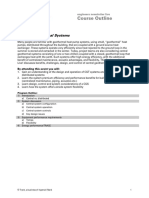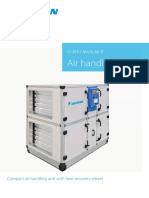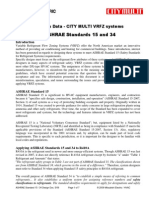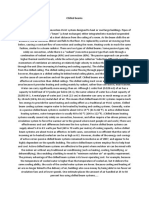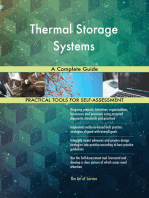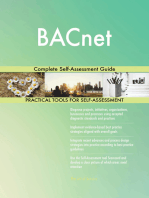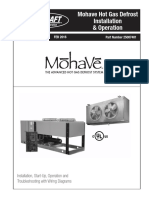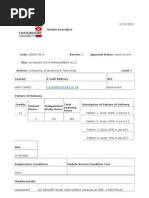Cloudfridge: A Cloud-Based Control System For Commercial Refrigeration Systems
Cloudfridge: A Cloud-Based Control System For Commercial Refrigeration Systems
Uploaded by
HoàngViệtAnhCopyright:
Available Formats
Cloudfridge: A Cloud-Based Control System For Commercial Refrigeration Systems
Cloudfridge: A Cloud-Based Control System For Commercial Refrigeration Systems
Uploaded by
HoàngViệtAnhOriginal Title
Copyright
Available Formats
Share this document
Did you find this document useful?
Is this content inappropriate?
Copyright:
Available Formats
Cloudfridge: A Cloud-Based Control System For Commercial Refrigeration Systems
Cloudfridge: A Cloud-Based Control System For Commercial Refrigeration Systems
Uploaded by
HoàngViệtAnhCopyright:
Available Formats
Cloudfridge: A Cloud-Based Control System for Commercial
Refrigeration Systems
Marco Graziano, Visible Energy, Inc.
Marco Pritoni, Western Cooling Efficiency Center, UC Davis
ABSTRACT
In California, commercial refrigeration accounts for 14% of electric energy usage,
corresponding to 9,014 GWh per year and affecting more than 110,000 commercial
establishments. A single walk-in freezer uses more energy than 5 single-family houses. Despite
more stringent standards and utility programs promoting hardware improvements, controls
systems used for commercial refrigerators are still primitive. In fact, in traditional refrigerators,
the vapor-compression cycle is controlled with a simple hysteresis controller to keep the air
cabinet temperature within a specific range. The controller does not account for system
dynamics, energy consumption, utility prices or recurrent events such as food loading schedules
and business opening hours. Also, demand response is precluded with these unsophisticated
controls. With the help advanced control theory and efficient optimization algorithms, computer-
based real-time optimization is now feasible and applicable in commercial refrigeration systems,
but its practical use to date has been limited to industrial systems requiring expensive on-premise
equipment and complex operations. This paper presents a novel hardware and software
architecture that allows advanced control algorithms for commercial refrigerators to be
developed, tested and deployed inexpensively. The aim of this new control framework is to
optimize energy consumption as a software task, utilizing the benefits of lower cost
computational resources inherent to cloud computing, minimizing on net overall energy usage of
the refrigeration system. A prototype of the proposed system has been developed and tested
under a California Energy Commission grant1.
Introduction
There are more than 12 million commercial refrigerators installed in the US (Table 1).
The vast majority of them, in particular walk-in coolers and freezers, food preparation equipment
and reach-in refrigerators still use primitive controls. Cludfridge targets primarily this large base
of unsophisticated systems.
In a traditional refrigerator, a thermostat controls the vapor-compression cycle with a
simple hysteresis scheme to keep the air cabinet temperature or in some cases the evaporator
temperature, within a specific range. The thermostat functioning parameters are set at the time of
fabrication and assembly, energy used is not measured and no factors relevant to energy
consumption dynamics are taken into consideration. With the help of advanced control theory
and efficient optimization algorithms, computer-based real-time optimization is now feasible and
applicable in commercial refrigeration systems, but its practical use to date has been limited to
industrial systems requiring expensive on-premise equipment and complex operations.
This project demonstrates a new way of operating commercial refrigerators, reducing in a
cost effective way their energy consumption while increasing their operational efficiency. The
1
Visible Energy, Inc. (2014) Cloud Based Refrigeration Control System, Final Report. California Energy Commission EISG
Program, Grant #: 57509A/1211. http://www.cloudfridge.io/
©2014 ACEEE Summer Study on Energy Efficiency in Buildings 11-285
method is deployed as an automated energy optimization service based on the unique
characteristics of each refrigerator and business. Additionally, this approach allows for insights
to be drawn across a wide range of installations.
Network latency and security have always been challenges in the implementation of
cloud-based control systems. Cloudfridge has been developed to provide secure and almost real-
time communication between the device and the remote control algorithm.
Table 1. Total installed base of refrigerators in the US in 2008 (DOE 2009a)
Total Primary Energy
Commercial Sector Technical Potential by Installed Base
Consumption
equipment type
[Units] [TWh / yr] [TBtu / yr]
(Supermarket)
Display Cases 2,100,000 214 730
Compressor Racks 140,000 373 1,273
Condensers 140,000 50 171
Walk‐ins 245,000 51 174
(Non‐Supermarket)
Walk‐in Coolers and Freezers 755,000 148 505
Food Preparation and Service Equipment 1,516,000 55 188
Reach‐in Refrigerators and Freezers 2,712,000 106 362
Beverage Merchandisers 920,000 45 154
Ice Machines 1,491,000 84 287
Refrigerated Vending Machines 3,816,000 100 341
Total 1,226 4,183
Background
Recent scientific literature on advanced control strategies applied to refrigeration or
HVAC shows the potential for substantial energy savings. A well-designed optimal control
scheme, continuously maintaining a commercial refrigeration system at its optimum operation
condition, despite changing environmental conditions, will achieve an important performance
improvement, both on energy efficiency and food quality reliability (Cai et al, 2008a). Several
alternative methods for establishing a control strategy that minimizes the overall energy
consumption in the refrigeration system have been described in the literature. For instance
Jakobsen and colleagues (2001) showed how to optimize set points for operating theoretical
refrigeration systems under certain constrains. Larsen and Thybo (2002) show significant energy
saving using flexible set points. In another paper, Larsen and colleagues created an indirect
method for optimization of the energy consumption (Larsen et al, 2005) and then they applied it
to a refrigerator model, resulting in energy usage reduction up to 20%. In (Stoustrup and
Rasmussen, 2008) food quality together with energy, are used as parameters to determine an
optimal time between defrost cycles. Based on this, a new defrost-on-demand method is
proposed. The method uses a feedback loop consisting of an on-line model updating and
estimation by an Extended Kalman Filter (EKF), as well as a model-based optimization. In (Cai
et al, 2008b) a new defrost, on-demand control scheme is described resulting in 25% energy
saving from performing the defrost cycles at the estimated energy optimal points. Cai also
©2014 ACEEE Summer Study on Energy Efficiency in Buildings 11-286
discusses how a well-designed optimal control scheme, continuously maintaining a commercial
refrigeration system at its optimum operation condition, can achieve an important performance
improvement in energy efficiency and without compromising food quality. Earlier studies
proposed fuzzy logic (Becker et al, 1994)) or neural networks (Choi et al, 1998) but they have
not been studied yet with the objective of reducing overall energy consumption. A computer-
based energy management system has been installed in the world’s largest integrated nylon plant
to optimize the refrigeration systems, and it proved a substantial energy cost reduction (Cho and
Norden, 1982). Up to date this research has found little implementation in the refrigeration
market, with a few exceptions in large refrigeration systems. Cloudfridge provides the
architecture to develop these new control methods inexpensively in any type of refrigerator.
Technology Developed
Under a California Energy Commission grant, Visible Energy, Inc. developed a cloud
infrastructure and related applications able to remotely manage, control and monitor commercial
refrigerators2. The goals of the project were to prove the feasibility and develop the infrastructure
as well the hardware and software tools of a cloud-based control for commercial refrigerators.
Its practical use will allow a larger number of research institutions and companies, even
without large R&D budgets, to experiment and test novel ideas for control methods that reduce
energy consumption or improve other aspects of their products using real systems and not only
mathematical models.
System Diagram
Figure 1 depicts Cloudfridge system diagram. The refrigerators on the left side are each
equipped with a purpose-made control and communication board, which connect to the Internet
over local Wi-Fi via a facility switch to reach the Internet and the control software residing in the
cloud. Given an available Wi-Fi network, the control and communication board is the only new
piece of equipment needed for a retrofit. The system does not need a full computer on the
premises. The board is installed outside the refrigerator.
The major innovation of this system is the collection of a large amount of data, including
energy consumption, and using it in the control method, implemented as software in a cloud
environment. Each refrigerator could potentially implement a different method, customized on
its technical and environmental conditions.
Hardware
The control and communication board developed allows both data acquisition from
sensors, including power consumption, and remote control of a refrigerator’s main components,
i.e. the compressor, the evaporator fan, and the defrost element, if present. The refrigerator’s
original thermostat is bypassed and the control loop is performed purely by the software running
remotely. The infrastructure allows near real-time access to the control board in the refrigerator.
A contract manufacturer has estimated the bill of materials for the control board to be about $50
per unit (at scale3). Additional sensors can be installed to measure food temperature, door
2
Open-source software components will be released under AGPL license (www.gnu.org/licenses/agpl-3.0.html).
3
Bill on materials for 10,000 pieces
©2014 ACEEE Summer Study on Energy Efficiency in Buildings 11-287
opening and ambient temperature. In case of lost connection the controller switches back to a
traditional fixed set-points operation.
Figure 1. CloudFridge system diagram.
Software
The Cloudfridge software infrastructure is composed of a back-end for 2-way device
secure communication, the sMAP Archiver and database, a highly efficient time series database
developed by UC Berkeley (Dawson-Haggerty et al. 2010), the software for control methods
execution (Workers Cluster), and an application server (Stardome), which provides the user
interface for the whole system. Cloudfridge is a distributed software system structured in four
main components, each of a certain complexity, but all capable of being distributed on a number
of servers. Figure 2 represent a map of Cloudfridge software architecture. It depicts the
computing resources, data flows and management underlying the cloud-resident control method
capabilities.
Cometa4 is the “secure switchboard” edge service5 used for data vetting and assured data
coherence across the Internet trust boundary. Cometa allows secure real-time HTTP
communication between an application server and the Amazon Redshift6 endpoints devices
connected to the refrigerators. Black arrows stand for internal data transfers separate from
Cometa. Colored arrows show specific types of data flows mediated by Cometa, most
4
Cloud infrastructure for embedded systems developed by Visible Energy Inc. http://www.cometa.io/
5
Computer for running middleware or applications that is close to the edge of the network, where the digital world
meets the real world. Edge servers are put in warehouses, distribution centers and factories, as opposed to corporate
headquarters.
6
Amazon data warehouse service
©2014 ACEEE Summer Study on Energy Efficiency in Buildings 11-288
prominently on the left side of the graphic, the red arrows representing data traffic from the
control and communication boards (Redshfit) to the sMAP Archiver and its data base(s). The
Workers Cluster runs the actual control method, using query data from the sMAP Archiver. Blue
and yellow arrows represent the command-response messages flowing between the Workers
Cluster and the endpoints. The modularity represented allows broader server distribution and
ultimately better scaling capacity.
Figure 2. CloudFridge software components.
The Stardome GUI interface includes:
1. Device Console for device creation and configuration (Figure 3)
2. Device Management, for receiving real-time data from devices, control method editing
and deployment through the Monitoring Panel (Figure 4) and the Development Console.
In the control execution environment (Astro OS, inside the Workers Cluster) each
refrigerator is associated with an independent thread of execution for its own control method
written in the Ruby language. A control loop can also invoke an external process such as Matlab
or Octave, to perform very sophisticated mathematical computations and use the results in
evaluating the optimal cooling strategy.
©2014 ACEEE Summer Study on Energy Efficiency in Buildings 11-289
Figure 3. Device Console in the Stardome application.
Figure 4. Monitoring Panel in Stardome application.
©2014 ACEEE Summer Study on Energy Efficiency in Buildings 11-290
Discussion
While the new method used in the test optimization has been achieved by writing the
software knowing the usage patterns and content, the optimization process can be easily
replicated in a class of refrigerated appliances, including higher energy usage ones, such as walk-
in boxes. The control software can be written directly in Ruby or can call external functions, for
example using advanced control tools available in Matlab.
This technology enables customizing a control sequence for each refrigerator based on
use patterns and type of application at very low cost. One can envision implementing demand
response through thermal storage only in vending machines, ice machine or freezers, while
saving energy in other refrigerators by optimizing defrost cycles. All these strategies can be
implemented with the same inexpensive hardware. Regulating set-points based on electricity
prices and anticipating compressor malfunction, thus preventing food losses, could achieve
additional operational cost savings.
Conclusions
The technology developed in this research greatly lowers the cost of implementation and
installation of state-of-the-art control methods in commercial refrigerated systems and self-
contained appliances, thereby lowering major barriers to adoption, whether through retrofit, or
by incorporation into newer refrigeration appliances and systems. Preliminary deployment test
show savings in the order of 20-50%. The technology implemented and demonstrated in the
project has a clear potential to disrupt standard practice in the commercial refrigeration industry.
It provides substantial energy savings benefits, increased operational efficiency, demand-
response capabilities, and fault detection and diagnostics at small marginal cost. Beyond the
initial objective of feasibility, the project has delivered a smart controller reference design ready
for production, and tools and functional software for deployment and commercialization of a
refrigeration energy optimization service.
Recommendations and Future Work
A clear next step for this technology is to develop different advanced controls methods
based on sensors data collected by the system. Using the online platform computation could be
performed in real-time in the cloud, not constrained by limited hardware resources of a
traditional refrigerator. One example of an energy optimized control strategy is called model
predictive control (Rossiter, 2003; Wang, 2009; Boyd 2012), which continuously adjusts the
refrigerator working parameters to optimize a function of energy, peak demand, cost, and food
quality. Machine learning algorithms can be used during operation of the system to automatically
detect usage patterns that can be incorporated in the advanced control method. While preliminary
testing has been done in the lab and at one location in the field, large-scale testing and energy
savings verification is essential to prove the technology for commercial adoption.
References
Becker M., Oestreich M., Hasse, H. and Litz L. (1994). Fuzzy control for temperature and
humidity in refrigeration systems. Proc. 3rd IEEE Conference on Control Applications,
Glasgow, UK, 1994.
©2014 ACEEE Summer Study on Energy Efficiency in Buildings 11-291
Boyd S., Hovgaard T., Larsen L., Jørgensen J. (2012). Nonconvex Model Predictive Control for
Commercial Refrigeration. International Journal of Control, 2012.
Cai, J. (2007). Control of refrigeration systems for trade-off between energy consumption and
food quality loss. Ph.D Thesis. Automation and Control Department of Electronic Systems,
Aalborg University, Denmark.
Cai, J., J.B. Jensen, S. Skogestad, J.Stroustrup (2008a). On the trade-off between energy
consumption and food quality loss in supermarket refrigeration systems. 2008 American
Control Conference. Seattle 2008.
Cai, J., J. Stoustrup, B.D. Rasmussen (2008b). An active defrost scheme with a balanced energy
consumption and food quality loss in supermarket refrigeration systems. Proc. 17th World
Congress, The International Federation of Automatic Control. Korea 2008.
CEC (2006). California Commercial End-Use Survey. California Energy Commission. 2006.
Cho, C. H. and Norden, N. (1982). Computer optimization of refrigeration systems in a
textileplant: a case history. Automatica, 18(6), pp. 675– 683.
Choi, B.J., S.W. Han, and S.K. Hong (1998). Refrigerator temperature control using fuzzy logic
and neural network. Proc. IEEE International Symposium on Industrial Electronics ISIE ’98,
Pretoria, South Africa.
CEC (2006). California Commercial End Use Survey. California Energy Commission. 2006.
Dawson-Haggerty S., Jiang X., Tolle G., Ortiz J, and Culler D.(2010). sMAP – a Simple
Measurement and Actuation Profile for Physical Information, Sensys 2010
http://www.cs.berkeley.edu/~stevedh/pubs/sensys10smap.pdf
Jakobsen, A., B.D. Rasmussen, M.J. Skovrup and J. Fredsted (2001). Development of energy
optimal capacity control in refrigeration systems. International Refrigeration Conference.
Purdue.
Larsen, L.S. and C. Thybo (2002). Potential energy savings in refrigeration systems using
optimal setpoints. Preprint version, Aalborg University.
Larsen, L.S. (2005). Model based control of refrigeration systems. PhD thesis, Department of
Control Engineering, Aalborg University, Denmark, 2005.
Rossiter, J. A. (2003). Modelbased Predictive Control: A Practical Approach: CRC Press.
Stoustrup J. and Rasmussen B.(2008). An Active Defrost Scheme with a Balanced Energy
Consumption and Food Quality Loss in Supermarket Refrigeration Systems. Proceedings of
the 17th World Congress The International Federation of Automatic Control Seoul, Korea,
2008.
©2014 ACEEE Summer Study on Energy Efficiency in Buildings 11-292
Wang, L. (2009). Model Predictive Control System and Design Implementation using
MATLAB.
©2014 ACEEE Summer Study on Energy Efficiency in Buildings 11-293
You might also like
- JSS 1 Ict 3RD Term Lesson NoteDocument16 pagesJSS 1 Ict 3RD Term Lesson NoteOyinade Adeolu100% (1)
- Managed Secure SD-WAN 6.4.4: Lab GuideDocument167 pagesManaged Secure SD-WAN 6.4.4: Lab GuideAntonio Pereda100% (3)
- eCO2Boost - Installation-Manual KYSOR WARREN PDFDocument52 pageseCO2Boost - Installation-Manual KYSOR WARREN PDFOmar MorenoNo ratings yet
- Dmitriyev & Pisarenko (1984)Document3 pagesDmitriyev & Pisarenko (1984)Francisco OppsNo ratings yet
- Oferta ZagmiDocument44 pagesOferta ZagmiMarian Florin MincinoiuNo ratings yet
- GEA Grasso SP2, Compressor Frame Size C - XFDocument40 pagesGEA Grasso SP2, Compressor Frame Size C - XFManuel MartinezNo ratings yet
- CGS Introduction LetterDocument8 pagesCGS Introduction LetterMuhammed Abo-FandoodNo ratings yet
- Mitsubishi Electric Zuba-DanDocument43 pagesMitsubishi Electric Zuba-Dana_mitic100% (1)
- Steam Fired IndiaDocument8 pagesSteam Fired IndiaSPY2YashNo ratings yet
- Horizontal Accumulator SelectionDocument14 pagesHorizontal Accumulator SelectionHoàngViệtAnhNo ratings yet
- NetHawk PosterDocument1 pageNetHawk Postertemplar59No ratings yet
- Industrial Refrigeration: Güntner CompetenceDocument19 pagesIndustrial Refrigeration: Güntner CompetenceWINNo ratings yet
- 15 PDFDocument173 pages15 PDFnascasNo ratings yet
- Desescarche Gas Caliente - Presión GuntnerDocument17 pagesDesescarche Gas Caliente - Presión GuntnerramonluhrNo ratings yet
- Refrigeration Cycle SimulationDocument14 pagesRefrigeration Cycle SimulationEduNo ratings yet
- Economies of Meat Chilling FreezingDocument11 pagesEconomies of Meat Chilling FreezingyemNo ratings yet
- GEA Grasso V Series: Reciprocating Compressors For Industrial RefrigerationDocument12 pagesGEA Grasso V Series: Reciprocating Compressors For Industrial RefrigerationHarsha Vardhan BNo ratings yet
- Absorption Cooling Systems - Review of VariousDocument32 pagesAbsorption Cooling Systems - Review of VariousSalomon CureNo ratings yet
- LH265E-S6F-30.2 R404A t0 - 28 Tamb 32Document6 pagesLH265E-S6F-30.2 R404A t0 - 28 Tamb 32Gosai MohamedNo ratings yet
- Aks4100 (Ficha Tecnica-Nivel de Liquido Danfoss)Document20 pagesAks4100 (Ficha Tecnica-Nivel de Liquido Danfoss)Crypto LegendNo ratings yet
- RETA Steel PipeDocument5 pagesRETA Steel PipeBehnam AshouriNo ratings yet
- Modulating Liquid Level Regulators Direct Operated, For Low Pressure SideDocument12 pagesModulating Liquid Level Regulators Direct Operated, For Low Pressure SideLucioRimacNo ratings yet
- MPR-414F MPR-414FS: Instruction ManualDocument29 pagesMPR-414F MPR-414FS: Instruction ManualAnonymous D8ay3BMJ5No ratings yet
- Stream User-ManualDocument36 pagesStream User-ManualSreekanth NakkaNo ratings yet
- Design and Simulation of Solar Powered Vapour Compression Refrigeration SystemDocument7 pagesDesign and Simulation of Solar Powered Vapour Compression Refrigeration SystemRohan BhairavkarNo ratings yet
- BAC Website CXVE EN 2021Document30 pagesBAC Website CXVE EN 2021Mahmoud AbubakrNo ratings yet
- Carcass Freezing Time Predication by Plate FreezerDocument6 pagesCarcass Freezing Time Predication by Plate FreezerSiti Farah LokmanNo ratings yet
- Ammonia Pump - InfoDocument4 pagesAmmonia Pump - InfoRicardoNo ratings yet
- Hot Gas DefrostDocument1 pageHot Gas Defrostarman_1287No ratings yet
- Micro Channel 1355150788Document2 pagesMicro Channel 1355150788Slim KanounNo ratings yet
- Low Ammonia Charge Refrigeration Systems For Cold Storage: White PaperDocument48 pagesLow Ammonia Charge Refrigeration Systems For Cold Storage: White PaperRASHEED YUSUFNo ratings yet
- Basic Data SheetDocument15 pagesBasic Data Sheeterkamlakar2234No ratings yet
- Phuong Phap Tinh Tai Theo Phan Mem MistralDocument8 pagesPhuong Phap Tinh Tai Theo Phan Mem Mistralntt_121987No ratings yet
- Course Outline: Central Geothermal SystemsDocument55 pagesCourse Outline: Central Geothermal SystemsjrodNo ratings yet
- Trane Cooling TowerDocument8 pagesTrane Cooling ToweramitbslpawarNo ratings yet
- Sabroe PPDocument28 pagesSabroe PPGPNo ratings yet
- Thermodynamic Chart R22Document20 pagesThermodynamic Chart R22vniranjanNo ratings yet
- D-AHU Modular R - Product Profile - ECPEN17-485 - EnglishDocument8 pagesD-AHU Modular R - Product Profile - ECPEN17-485 - EnglishShehan WijesingheNo ratings yet
- Cooltech Prsentation - May 2016Document12 pagesCooltech Prsentation - May 2016Cooltech ApplicationsNo ratings yet
- Technical Data PRIHODADocument32 pagesTechnical Data PRIHODAAlex PotaNo ratings yet
- Condenser: Conference ExhibitionDocument44 pagesCondenser: Conference ExhibitionHarsha Vardhan BNo ratings yet
- Grasso Screw Compressor Package Pi - tcm11 38504Document84 pagesGrasso Screw Compressor Package Pi - tcm11 38504Twfeek AhmedNo ratings yet
- High Pressure Lift Ejector and Liquid Ejector Systems: Application GuideDocument28 pagesHigh Pressure Lift Ejector and Liquid Ejector Systems: Application Guidejvc hemitNo ratings yet
- Thermo Physical Properties of Aqueous Solutions - Secondary FluidDocument144 pagesThermo Physical Properties of Aqueous Solutions - Secondary FluidsrshahNo ratings yet
- HUSSMANN Line - Sizing - Refrig - Data - Guide - 101717 PDFDocument32 pagesHUSSMANN Line - Sizing - Refrig - Data - Guide - 101717 PDFAnonymous 5moojwNo ratings yet
- Propriété de Panneaux OSBDocument42 pagesPropriété de Panneaux OSBabossuyt1904100% (1)
- Conley Et Al. - 2018 - 2.24 Insulation MaterialsDocument36 pagesConley Et Al. - 2018 - 2.24 Insulation Materialsminsara madtNo ratings yet
- Mar305-0 Tech Data CXVDocument8 pagesMar305-0 Tech Data CXVgoodspeed_phNo ratings yet
- CO2 Systems - Trends Benefits and ROIDocument33 pagesCO2 Systems - Trends Benefits and ROIOnofreNo ratings yet
- Heat Pumps Co2Document8 pagesHeat Pumps Co2Domagoj VulinNo ratings yet
- Ashrae 15-34-Rev 3 MitsubishiDocument7 pagesAshrae 15-34-Rev 3 MitsubishiJosho SandovalNo ratings yet
- ENGINEERING DATA VRV III System-Daikin PDFDocument746 pagesENGINEERING DATA VRV III System-Daikin PDFĐỗ Xuân QuânNo ratings yet
- R407C PDFDocument20 pagesR407C PDFAllizhita Lorena ProañoNo ratings yet
- Chilled BeamsDocument1 pageChilled BeamsrkibNo ratings yet
- Webinar Distribution Centres enDocument27 pagesWebinar Distribution Centres enMilorad LazovicNo ratings yet
- Frigoscandia: Flofreeze - IQF FreezersDocument6 pagesFrigoscandia: Flofreeze - IQF FreezersAhmed ShatlaNo ratings yet
- Coil Selection GuideDocument21 pagesCoil Selection GuideKaiser IqbalNo ratings yet
- VRV Heat Recovery REYQ-XDocument20 pagesVRV Heat Recovery REYQ-XFrancisco LinaresNo ratings yet
- Danfoss Refrigerants White Paper Dec 2017 PDFDocument24 pagesDanfoss Refrigerants White Paper Dec 2017 PDFjms26985No ratings yet
- Mechanical System Modeling Guide: Variable Refrigerant Flow (VRF) SystemsDocument15 pagesMechanical System Modeling Guide: Variable Refrigerant Flow (VRF) SystemsElie BaradhyNo ratings yet
- Mechanical System Modeling Guide: Variable Refrigerant Flow (VRF) SystemsDocument15 pagesMechanical System Modeling Guide: Variable Refrigerant Flow (VRF) SystemsAnonymous 73gEYyEtLNo ratings yet
- Backup of TbankstartupDocument5 pagesBackup of TbankstartupHoàngViệtAnhNo ratings yet
- Freeze For Less Anatoli Naoumov SlidesDocument30 pagesFreeze For Less Anatoli Naoumov SlidesHoàngViệtAnhNo ratings yet
- What Is SubcoolingDocument3 pagesWhat Is SubcoolingHoàngViệtAnhNo ratings yet
- Backup of TbankstartupDocument5 pagesBackup of TbankstartupHoàngViệtAnhNo ratings yet
- Cubic: CompactDocument5 pagesCubic: CompactHoàngViệtAnhNo ratings yet
- Aalborg Universitet: Cai, Junping Stoustrup, Jakob Rasmussen, Bjarne DindlerDocument7 pagesAalborg Universitet: Cai, Junping Stoustrup, Jakob Rasmussen, Bjarne DindlerHoàngViệtAnhNo ratings yet
- Condensing Units: Installation and Operations ManualDocument40 pagesCondensing Units: Installation and Operations ManualHoàngViệtAnhNo ratings yet
- H Im HGD - MohaveDocument69 pagesH Im HGD - MohaveHoàngViệtAnhNo ratings yet
- Hot Gas Defrost - Final ReportDocument22 pagesHot Gas Defrost - Final ReportHoàngViệtAnhNo ratings yet
- Refrigeration Is All About Phase Change: - So Is Liquid HammerDocument33 pagesRefrigeration Is All About Phase Change: - So Is Liquid HammerHoàngViệtAnhNo ratings yet
- Demand Defrost Strategies in Supermarket Refrigeration SystemsDocument33 pagesDemand Defrost Strategies in Supermarket Refrigeration SystemsHoàngViệtAnhNo ratings yet
- Optimizing Hot Gas DefrostDocument9 pagesOptimizing Hot Gas DefrostHoàngViệtAnhNo ratings yet
- Ke2 Evaporatorefficiency: Theory of OperationDocument8 pagesKe2 Evaporatorefficiency: Theory of OperationHoàngViệtAnh100% (1)
- Parametric Evaluation of A Nh3/Co2 Cascade System For Supermarket Refrigeration in Laboratory EnvironmentDocument95 pagesParametric Evaluation of A Nh3/Co2 Cascade System For Supermarket Refrigeration in Laboratory EnvironmentHoàngViệtAnhNo ratings yet
- XĐ by Hot GasDocument71 pagesXĐ by Hot GasHoàngViệtAnhNo ratings yet
- XĐ by Hot Gas 2Document32 pagesXĐ by Hot Gas 2HoàngViệtAnhNo ratings yet
- Trend Study The Future of Intellectual PropertyDocument65 pagesTrend Study The Future of Intellectual PropertySidhharrth S KumaarNo ratings yet
- Usage of E-Banking Services Among Rural Customers in KeralaDocument6 pagesUsage of E-Banking Services Among Rural Customers in KeralaInternational Journal of Innovative Science and Research TechnologyNo ratings yet
- Huawei EchoLife HG8447 (GPON) Brief Product Brochure (2011-01-20) PDFDocument2 pagesHuawei EchoLife HG8447 (GPON) Brief Product Brochure (2011-01-20) PDFLonaBRNo ratings yet
- CCNA 200-125 (406 Questions)Document174 pagesCCNA 200-125 (406 Questions)Aislan SoaresNo ratings yet
- Asm CmdsDocument4 pagesAsm Cmdssaravanand1983No ratings yet
- Web Design: Professional Diploma inDocument9 pagesWeb Design: Professional Diploma inwizdom20032001No ratings yet
- STD IVDocument3 pagesSTD IVdavidshenbaNo ratings yet
- System Analysis and Design-Purbanchal University Notes For BIT/BCADocument39 pagesSystem Analysis and Design-Purbanchal University Notes For BIT/BCAInfinity GB50% (2)
- E Justice-Report 05Document54 pagesE Justice-Report 05sodkhuuNo ratings yet
- Progress Test 1 (Units 1 - 3) : ListeningDocument11 pagesProgress Test 1 (Units 1 - 3) : ListeningИра100% (1)
- Communication Technology and Society PDFDocument2 pagesCommunication Technology and Society PDFAddisonNo ratings yet
- Winsock Socket Programming in C On WindowsDocument21 pagesWinsock Socket Programming in C On WindowsLova NugrohoNo ratings yet
- The Emerging Role of Banks in EcommerceDocument5 pagesThe Emerging Role of Banks in EcommercePrerna SharmaNo ratings yet
- LogDocument24 pagesLogMarcos Chevez ArroyoNo ratings yet
- 2021 Marketing Plan Template (Mayple)Document53 pages2021 Marketing Plan Template (Mayple)Fery Haidir100% (1)
- How Long Can You Be Alone in A Call in A Discord Group Chat - Google SearchDocument1 pageHow Long Can You Be Alone in A Call in A Discord Group Chat - Google SearchwillaberkowitzNo ratings yet
- Module DescriptorDocument18 pagesModule DescriptorLocher-Emoit Bengo OnyukaNo ratings yet
- Leica Geosystems Monitoring Solutions Brochure PDFDocument2 pagesLeica Geosystems Monitoring Solutions Brochure PDFpradeep singhNo ratings yet
- Video VortexDocument324 pagesVideo VortexInstitute of Network CulturesNo ratings yet
- PC Desktop Guide PDFDocument6 pagesPC Desktop Guide PDFAnonymous 4hnrh9No ratings yet
- Telnet: There Are Two Types of LoginDocument4 pagesTelnet: There Are Two Types of Loginsampath998No ratings yet
- Az-700 Aa14cfb6e778Document100 pagesAz-700 Aa14cfb6e778pankajvistascloudNo ratings yet
- History of Polonix 2Document4 pagesHistory of Polonix 2hafeez arshadNo ratings yet
- Group Discussion: Topic: Thoughts of InternetDocument8 pagesGroup Discussion: Topic: Thoughts of InternetParamasivam SivamNo ratings yet
- Exam JN0-664 Topic 1 Question 7 Discussion - ExamTopicsDocument2 pagesExam JN0-664 Topic 1 Question 7 Discussion - ExamTopicsherbakNo ratings yet
- Techincal English For Computer Science Course Book For The Academic Year 2010-2011Document54 pagesTechincal English For Computer Science Course Book For The Academic Year 2010-2011Evan ThomasNo ratings yet
- Subnetting QuizDocument10 pagesSubnetting QuizRomelyn SantosNo ratings yet

































